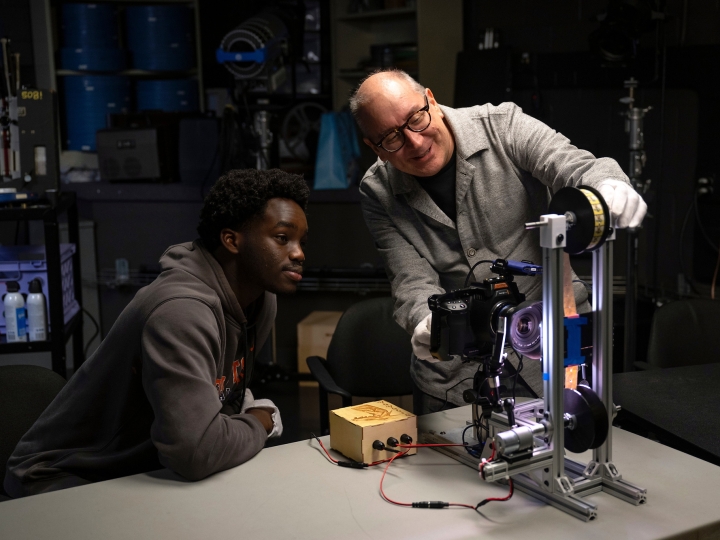Bucknell Students Refine Next-generation Medical Technologies
June 29, 2018
Bucknell computer science major Jason Kang '21 is just beginning to learn to code, but he's refining his skills on a program that has helped thousands make an undeniable improvement in their health and well-being.
Kang is working with Professor Lea Wittie, computer science, on Get 2 Goal, a smartphone app that helps patients who've undergone a type of bariatric surgery achieve their weight-loss goals. Developed in collaboration with the Geisinger Obesity Institute in nearby Danville, Pa., the app has been downloaded by more than 8,000 users around the world.
Get 2 Goal provides patients with customized graphics showing how much weight they should expect to have lost at any point following their surgery, based on a host of personalized factors such as height, weight before surgery, gender and medical history. To further its development, Kang has not only worked side-by-side with his professor, but also with physicians and researchers at the Geisinger Health System.
"It's only been one year since I came to college and I've only taken the introductory courses, but now I'm here learning this new language and creating something that can help people change their lives," said Kang, a Posse Foundation scholar from South Pasadena, Calif. "It's definitely an experience that I like and one I want to build on and continue to dedicate myself to."
Find Your Path
Kang is able to take part in this skill-building experience — one he'll continue into the fall semester — thanks to the Joseph A. Ciffolillo ’61 Healthcare Technology Inventors Program (HTIP), a new grant-making initiative to move promising medical technologies through development while provide career-building experiences for students. Established through a gift from trustee emeritus Joseph Ciffolillo '61, HTIP funded its first three projects this spring with awards of between $5,000 and $10,000, allowing Bucknell undergraduates to share in the real-time development of medical technologies with the potential to change lives.
"The No. 1 goal is the impact on the students," said Professor Dan Cavanagh, biomedical and chemical engineering, the program's inaugural director. "We have an opportunity to develop valuable, patentable devices through this program, but what most excites me about it is the opportunity for students to work with faculty on these types of projects."
Opening Doors for Students
In fact, one of the projects that was funded this year began as an entirely student-driven effort. Pauline Collamore '18 began working on an arm brace for stroke rehabilitation during an internship at Medstar rehabilitation center in Washington, D.C. and brought it to Bucknell as a mechanical engineering senior design project last year. The student design team's adviser, Professor Charles Kim, is working this summer with two research interns from the Delft University of Technology, in the Netherlands, to build on their efforts through his HTIP grant. He envisions more Bucknell students taking part in the project in the years to come.
Kim, a professor of mechanical engineering, said the Ciffolillo funding helps projects traverse the proverbial "valley of death" of product development and refinement, when the funding that's available at more fundamental research stages tends to dry up.
"If you want to make something into a practical, real-world piece of technology and the funding isn't as readily available, that's where HTIP fits in," Kim said. "We finished this great senior design project, but now we can continue to the next level."
Another key focus of the program is to support projects with the potential for impact far beyond Bucknell. Grant recipient Philip Asare, a professor of electrical & computer engineering, said the patient simulator he's building with undergraduate Dikendra Karki '19, an electrical engineering major from Nepal, could assist in the development of systems that integrate multiple medical devices to achieve their goals.
"Everything we're doing is doing what engineers actually do for real systems," said Asare, noting that while other medical simulators exist, they're typically designed for training doctors, not testing systems of devices and often cost in excess of $100,000. The device he and Karki are designing in collaboration with software firm Kitware will be open source, meaning its code will be available for anyone to use and modify freely.
"We're trying to provide tools for people at low cost and with the added advantage of having the open-source community behind it," Asare said. "It's comfortable to just do your own thing, but it's much more exciting when you know that other people actually use what you design."

